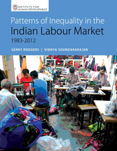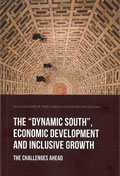 Welcome to the LMI Welcome to the LMI |
| |
|
|
| |
|
|
|
| |
| FORTHCOMING BOOK |
Growth, Labour and Inequality in Brazil and India: A comparative study
By Alexandre de Freitas Barbosa, Maria Cristina Cacciamali, Taniya Chakrabarty, Nandita Gupta, Gerry Rodgers, Janine Rodgers and Fabio Tatei.
To be published in 2016
This book brings together results from different parts of the LMI project into an integrated comparative analysis of patterns of growth and inequality in Brazil and India. It is built around a long term historical study of the patterns of growth that have emerged in the two countries, and their consequences for inequality; and combines this with an analysis of labour market structures, wages and employment. The book examines inequality both in the sense of overall distributions of income and expenditure, and in terms of disparities across gender, region, caste, race, and access to education. It compares the experience of the two countries, and draws conclusions on the types of policy frameworks that might lead to a more equitable pattern of growth.
|
| |
|
| |
| BOOKS |
 Patterns of Inequality in the Indian Labour Market 1983 – 2012
Patterns of Inequality in the Indian Labour Market 1983 – 2012
by Gerry Rodgers and Vidhya Soundararajan
Price: Rs. 895; 136 Pages
Published: 2016
Publisher: Academic Foundation and IHD
ISBN: 97893327035
This book is a systematic analysis of inequality in India and how it has been changing since the 1980s. It is focused on the labour market, and in particular on wage inequality, and also examines inequality in household expenditure. The book looks into the structure and segmentation of the labour market, both in terms of the nature of employment (casual and regular work) and in terms of some of the key divides: gender, caste and community, region and education. All of these factors are examined using National Sample Survey data, exploring the role of each in the overall pattern of inequality, and how their significance has been changing over time. A multivariate analysis brings these different factors together and assesses their relative importance. The monograph also considers the relationships between different aspects of inequality, comparing inequality of wages, income and expenditure, and discusses the changing share of labour income in value added. A final section examines the role played by occupational patterns and changes in the overall structure of labour market inequality.
Presentation 
 The “Dynamic South”, Economic Development and Inclusive Growth: The Challenges Ahead
The “Dynamic South”, Economic Development and Inclusive Growth: The Challenges Ahead
Edited by Alexandre Barbosa, Maria Cristina Cacciamali
Pages: 192
Published: 2013
Publisher: IDRC, CEBRAP & ABET
Co-publisher: IDRC,
ISBN: 978-85-62676-18-5
What do these countries – Brazil, China, India and South Africa - have in common? Is it possible to analyze them from a comparative perspective that, rather than abstracting their differences, highlights them? To what extent are the development and social inclusion challenges faced by these countries analogous? How can an understanding of each country’s development pattern inspire solutions for these challenges? These are some questions this book raises, to which we are sure not to find definitive answers. At any rate, our expectation is to open up a broad field of investigation.
This book is the result of an institutional effort that brought together a number of organizations. From the financial and intellectual support of IDRC (International Development Research Centre); to that of ABET (Brazilian Association for Labor Studies) and CEBRAP (Brazilian Center for Analysis and Planning) for organizing the opening conference at ABET’s 12th Congress – held in João Pessoa, Brazil, on September 2011 -, from which it resulted; to the relevant participation of IHD (Institute of Human Development) and ISLE (Indian Society of Labor Economics), both headquartered in India.
What drives these various agents is the assumption that South-South cooperation must go beyond expanding trade, investment, and technology flows across countries. The pursuit, therefore, is to stimulate critical reflection about the development patterns of those economies which have been recently given a few new labels – “emerging”, according to the definition of the IMF and other financial institutions; “dynamic South”, by UNCTAD (United Nations Conference on Trade and Development); BRICS, by economists with Goldman Sachs; and so forth.
In short, this book aims to putting forth an analytical framework – or at least some hypotheses in this direction - on the specificities of these economic and social structures, without concealing these countries’ profound differences in relation to one another, or that economic growth, in most of the cases, tends to accelerate social and regional disparities. What’s more, their labor markets are extremely segmented, with a prevalence of structural labor surplus and an informal economy of a sizable dimension. Besides, there is no sign that these problems are being faced on the basis of development strategies oriented toward social inclusion and inequality reduction.
The four countries selected in this book have in the years 2000 displayed a very peculiar combination of economic dynamism, labor market performance and implementation of social policies, with differing impacts on poverty and inequality. It is believed that comparison across these distinct development patterns may result not only in a prolific theoretical exercise, but also and foremost, in an assessment of the potential for exchanging positive and negative features of the experiences analyzed which eventually may lead to potential changes in terms of the public policies conducted.
The interest in studying the countries that this book focuses on lies in understanding the emergence of new “varieties of capitalism” which are not self-contained but, rather, complementarily and contradictorily integrated within the new capitalist world-economy.
The four chapters – written by distinguished authors from each of the countries covered – deal with the impacts of the economic dynamics on the labor market, basically on employment levels, wage behavior, and income disparities, before and after the 2008 crisis. As we can see, the various shapes of these countries’ labor markets, in interaction with distinct development patterns, have prompted different impacts in terms of poverty and inequality.
The great challenge these countries must face in the near future – especially in a setting of semi-stagnation of the economies of the North Atlantic, as observed in 2011/2012 – is to inject dynamism into their domestic markets while simultaneously changing their development patterns in order to increase job-generation capacity and overhaul their social inclusion policies to keep consistently reducing their high levels of inequality.
PDF available here 
 Aligning economic and social goals in economies: Employment and social protection in Brazil, China, India and South Africa
Edited by Gerry Rodgers
Aligning economic and social goals in economies: Employment and social protection in Brazil, China, India and South Africa
Edited by Gerry Rodgers
Price: Rs. 895; Hb; 176 pages
Published: 2013
Publisher: Academic Foundation and Institute for Human Development
Co-publisher: IDRC, Canada and ICSSR, New Delhi
ISBN: 978-81-7831-319-6
One of the central dilemmas of development is how to ensure that growth is both rapid and equitable. Employment is the key, but the employment performance of most economies leaves a great deal to be desired. The bulk of the population in low- and medium-income countries to scrabble for casual work, in informal labour markets, at poverty-level incomes. Dealing with such vulnerabilities calls for effective systems of social protection. But in the developing world, only a minority, and usually a small minority of the population, is protected by formal social security mechanisms.
Good economic performance in the last decade in large emerging economies of Brazil, India, China and South Africa gives hope that solutions might be found. Each of these countries has tried to tackle these issues, applying different policies and encountering differing degrees of success. This book documents and highlights four challenges faced in all four countries: converting growth into employment; building good labour institutions; finding the right balance between social protection and job creation; and dealing with inequality.
|
|
|
| |
 Welcome to the LMI
Welcome to the LMI